Biographical Sketch
 BORN IN PATERSON, N.J., in September 1934, Kluger is the son of David Kluger, a New York businessman, and Ida Kluger. After his parents divorced when he was seven years old, Kluger grew up living with his mother, Ida, and older brother, Alan, on the Upper West Side of New York. Though neither of his parents completed high school, they made sure their two sons had the advantage of a good education. Both graduated from the academically demanding Horace Mann School in the Riverdale section of the Bronx, at the end of a 50-minute daily commute by subway. Alan was an honors graduate of the University of Pennsylvania’s Wharton School of Finance, and Richard went to Princeton, attaining honors as an English major. But his principal pursuit at college was the school newspaper, The Daily Princetonian, of which he served as chairman in 1955-56.
BORN IN PATERSON, N.J., in September 1934, Kluger is the son of David Kluger, a New York businessman, and Ida Kluger. After his parents divorced when he was seven years old, Kluger grew up living with his mother, Ida, and older brother, Alan, on the Upper West Side of New York. Though neither of his parents completed high school, they made sure their two sons had the advantage of a good education. Both graduated from the academically demanding Horace Mann School in the Riverdale section of the Bronx, at the end of a 50-minute daily commute by subway. Alan was an honors graduate of the University of Pennsylvania’s Wharton School of Finance, and Richard went to Princeton, attaining honors as an English major. But his principal pursuit at college was the school newspaper, The Daily Princetonian, of which he served as chairman in 1955-56.
The origins of Kluger’s love affair with the written word have always been obscure to him. No one else in his family showed much interest in literature or had any special gift for writing. The only books in his home were boys’ adventure novels and Albert Payson Terhune’s anthropomorphic books about dogs, creatures of limited interest to a city lad. But he devoured all print matter he could get his hands on at a modest cost – newspapers (New York then had eight dailies), especially their sports pages, and general magazines like Life, Look, and The Saturday Evening Post. Their language was accessible, and he took to writing even as a grade-schooler, editing the mimeographed monthly Voice of the School at the Ethical Culture School, and producing the newspaper at his summer camp in the Berkshires as a teenager. At Horace Mann, he received a rigorous grounding in grammar, syntax, and rhetoric, had several stories published in the student literary magazine, and wrote for the weekly newspaper, The Record, of which he became editor-in-chief.
At Princeton
Attending college in the relatively peaceful years after World War Two and the Korean conflict but before the consciousness-raising upheavals of the late fifties and 1960s, Kluger encountered little social ferment on the largely conservative Princeton campus – there were few “causes” that drew his schoolmates’ attention to the wider world. He broke into print in his freshman year, writing regularly for the “Prince,” as the student paper was called, and contributing to the Tiger, the student humor magazine then edited by John McPhee, who would go on to become a master of nonfiction in a long writing career based at The New Yorker. During Kluger’s years on its staff, The Daily Princetonian enjoyed something of a golden age of young talent. Among his fellow “Prince” writers were Robert A. Caro, R.W. Apple, Jr., William Greider, and James Ridgeway, who would all go on to national renown as journalists and nonfiction book authors.
While a “Prince” reporter, Kluger tried to obtain an interview with Princeton’s most famous resident, Albert Einstein, who lived only a few blocks from the university campus but was unaffiliated with it. In his letter to the celebrated physicist, sent in the era when Senator Joe McCarthy was using militant anticommunism to ride to power as a demagogue terrorizing the political left, Kluger politely asked whether scientists hauled before congressional inquisitors might not be better off admitting their earlier flirtations with socialist doctrines and activities while capitalism was badly fraying in the 1930s rather than hiding behind the Fifth Amendment and inviting the inference that they were therefore less than patriotic Americans. Einstein wrote back to him at once, in a typed letter dated September 17, 1953:
Dear Mr. Kluger:
This answer to your letter of September 16th is not for publication for I have already expressed my opinion publicly.
As long as a person has not violated the “social contract” nobody has a right to inquire about his or her personal convictions. If this principle is not strictly followed free intellectual development is not possible and a state of uneasiness and hypocrisy unavoidable. You can observe this easily in our country at the present time.
Sincerely yours
s/A. Einstein.
Albert Einstein
A year later, Kluger did manage to obtain an interview with the director of the Institute for Advanced Study, where Einstein did his work – Dr. J. Robert Oppenheimer. The only condition of the interview was that Oppenheimer, then known as “the father of the atomic bomb,” would not discuss with Kluger the recent withdrawal of his security clearance by the Atomic Energy Commission for failing to report efforts by known communists to get him to divulge military secrets for transmission to the Soviet state. But in the course of his interview with young reporter Kluger, Oppenheimer predicted imminent widespread use of atomic power to meet the world’s need for peacetime energy.
When Einstein died in April of 1955, Kluger heard the news on his way to an 8:40 morning lecture, turned around, and headed straight for the “Prince” office, where by noon his staff managed to produce a one-page “extra” reporting on the world figure’s demise. In the regular edition of the paper the following day, Kluger wrote an editorial tribute to the scientist whose theories were instrumental in ushering in the age of nuclear physics but with it, the specter of atomic holocaust. It read in part:
Dr. Albert Einstein lived in our midst – right down the street, quite literally – yet lived a life so dramatic, so intense, so utterly inscrutable to most of us that his proper home was not Princeton, but the universe…. The peoples of the world must now move through Dr. Einstein’s time and space without the aid of his gigantic mind. We can venture but a guess as to the meaning of that mind; we can venture but a guess as to the consequences – for either progressive good or abysmally destructive evil – of his life’s work.
As chief editor of The Daily Princetonian, Kluger gave it a more literary bent, turning its editorial page over to a rotating panel of gifted young columnists, including satirical commentary from the conservative side by classmate Charles A. Fried, later to serve as U.S. Solicitor General under Ronald Reagan. Kluger himself contributed a (somewhat self-indulgent) humor column, “Paws and Ivy,” and gave its editorials a liberal tinge, hardly the preferred political shading among his fellow undergraduates of the day.
J-School Dropout
Over summers during his last two years at college Kluger began working professionally in journalism as a reporter in 1955 at the Paterson Evening News and in 1956 at the sprightly written Newark Star-Ledger. After Princeton he enrolled at the Columbia School of Journalism, serving as the campus correspondent for The New York Times. But he grew bored by the rudimentary writing exercises and make-believe reporting that took up much of the j-school’s curriculum and quit to take a job as a copy editor on the rim of The Wall Street Journal, allowing him to marry Phyllis Susan Schlain, whom he had met during his sophomore year at Princeton and courted steadily thereafter. Eager to put his writing talents to work, he later moved from the Journal to the city staff of the (then liberal) New York Post, covering a wide variety of stories as a reporter for the afternoon paper, which allowed its writers considerable stylistic latitude.
In the two years between those jobs, Kluger and his wife began and operated – on the proverbial shoestring – a new weekly newspaper, The Clarkstown Citizen, in New City, Rockland County, probably the only county seat within 200 miles of New York that did not already have a paper of its own. After getting it off the ground, Kluger raised $25,000 from several dozen residents in the community who appreciated having an independent newspaper to cover its civic, social, and cultural affairs. After pushing the Citizen’s circulation over 5,000 copies a week, the Klugers ran out of money and backers and sold their weekly to a radio station across the Hudson in Peekskill. Among the paper’s enthusiastic subscribers was the editorial page editor of the New York Post, who opened the door to Kluger’s gaining a staff job there.
After reporting on the grainy side of city life for two years on the Post, he turned his efforts to writing about the movers and shakers of corporate America for Forbes magazine, which often inspired dread among corporate executives for its critical examination of their bottom-line performances. Kluger’s final assignment there was a cover story on MetLife, privately owned at the time and the nation’s largest insurance company, which had never before opened its doors to journalistic inquiry. It took Kluger four of the six weeks allotted for the story to figure out what questions to put to the financial behemoth’s top brass.
He switched from writing about money and industry to dealing with the literary world when an opportunity arose for him to join the Sunday staff of the New York Herald Tribune. Uunder imaginative new editorial direction and a multimillionaire owner (John Hay Whitney), the “Trib” was creating a sensation by reconfiguring the daily American newspaper. Kluger’s job was to run Book Week, the Trib’s Sunday literary supplement, which was syndicated as well to the Washington Post, Chicago Sun-Times, and the San Francisco Examiner, with a combined circulation base that allowed it to challenge the Times Book Review for supremacy as the leading newspaper reviewing medium. Blessed with superior graphics and gifted editors, Book Week specialized in enlisting top writers and scholars to produce scintillating essay-reviews, like Saul Bellow’s piece on Theodore Sorensen’s biography of John F. Kennedy, Gore Vidal on Henry Miller’s trilogy of Sexus, Nexus, and Plexus, and Norman Mailer blistering LBJ’s campaign screed, My Hope for America. Book Week put Ralph Nader’s first book, Unsafe at Any Speed, issued by a small publisher, on its front page with an admiring review by the former head of Consumers Union and lured charismatic actor Richard Burton to review a biography of fellow Welshman Dylan Thomas.. Other prominent contributors were Susan Sontag, Daniel J. Boorstin, (the “bad” but brilliant) John Simon, the witty liberal Victor Navasky, and articulate conservative Russell Kirk.
Into Book Publishing
After four years, Kluger, by then more an editor than a writer (though he contributed occasional reviews to Book Week), left the Herald Tribune shortly before its demise to enter the book-publishing world. He joined the lively firm of Simon and Schuster, perhaps the most eclectic house in the trade, as a senior editor and member of the editorial board, specializing in nonfiction works. Among the books he brought to S&S were Richard Schickel’s biography, The Disney Version; Robert Caro’s The Power Broker, the life and times of Robert Moses (eventually issued by Knopf); The Case Against Congress by ace muckrakers Drew Pearson and Jack Anderson; From Those Wonderful Folks Who Gave You Pearl Harbor by zany advertising executive Jerry della Femina; Crime in America by former U.S. Attorney General Ramsey Clark; The Inner City Mother Goose, devastating social satire in verse by Eve Merriam, and Lawrence and Oppenheimer by Nuel Pharr Davis.
After advancing to managing editor and then executive editor at S&S, Kluger was offered the post of editor-in-chief at Atheneum Publishers, a smaller but more literary house that produced books of handsome design. At Atheneum he published such works as Kennedy Justice by Victor Navasky; Richard Rhodes’s first book, The Inland Ground; The Red Hot Vacuum by astute literary critic Theodore Solotaroff; Down the Rabbit Hole, insightful essays by Selma Lanes on children’s literature, and Who Pushed Humpty Dumpty? by Donald Barr, headmaster of New York’s highly regarded Dalton School. In 1970, the Klugers and their two small sons, Matthew and Ted, moved from New York’s Central Park West to Ridgefield, Connecticut, and lived there and in New Haven for the next thirteen years.
After a dispute with Atheneum’s owners over what Kluger felt was their failure to promote and market the house’s books vigorously, he was enlisted by the David McKay Co. to start his own imprint, Charterhouse Books. Two years into the effort and despite its promising start, he had to resign because of a retinal disease that hampered his vision and slowed his reading ability, a serious handicap, given his occupation. It was then that Kluger turned to writing fulltime.
Author
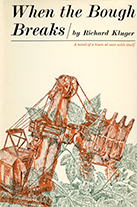 While at the Herald Tribune, Kluger had published his first novel, When the Bough Breaks (1964), based loosely on events and attitudes he had encountered during his days running a weekly in Rockland County. He had shown an early draft of the novel to the husband of one of his staff members, an editor in the trade division at McGraw-Hill, who encouraged him to pursue the project. Later, while on the Trib’s book review, he was asked to see the manuscript by the publicity director at the big publishing house of Doubleday & Co. and was offered a contract for it. A second novel, National Anthem, a satiric adventure yarn, followed and was bought by Harper & Row, which issued it while Kluger was at Simon and Schuster. Both books received some admiring notices, including one in the Beitish Times Literary Supplement, but neither made a commercial splash.
While at the Herald Tribune, Kluger had published his first novel, When the Bough Breaks (1964), based loosely on events and attitudes he had encountered during his days running a weekly in Rockland County. He had shown an early draft of the novel to the husband of one of his staff members, an editor in the trade division at McGraw-Hill, who encouraged him to pursue the project. Later, while on the Trib’s book review, he was asked to see the manuscript by the publicity director at the big publishing house of Doubleday & Co. and was offered a contract for it. A second novel, National Anthem, a satiric adventure yarn, followed and was bought by Harper & Row, which issued it while Kluger was at Simon and Schuster. Both books received some admiring notices, including one in the Beitish Times Literary Supplement, but neither made a commercial splash.
A major part of Kluger’s work at S&S was to dream up nonfiction book ideas and to seek writers to undertake them. In 1968, a year of immense social unrest throughout the nation as the civil rights, antiwar (Vietnam), women’s liberation, environmental, and consumer movements all seemed to converge, Kluger set out to find an author for an account of the landmark school desegregation decision, Brown v. Board of Education, handed down in 1954 by the U.S. Supreme Court. Because the subject involved so many allied subjects – the whole black experience in America till that time, an understanding of U.S. constitutional law and the workings of the highest court in the land, and access to the African-American community, among other things – he had no takers for the idea. Academics didn’t want to undertake all the reporting and legwork in the field, and journalists lacked the historical and legal knowledge for the job. But Kluger, feeling himself distanced from the profound social confrontations of the day, was convinced that an intensely dramatic and revelatory story was there for the telling. Although he was neither a lawyer nor a historian nor a black, he decided to seek a contract to write the book himself, hoping to research it in his spare time for as long as it took and then planning to take a leave of absence from his publishing job to do the actual writing.
A visit to the offices of Jack Greenberg, Thurgood Marshall’s successor as director of the NNACP Legal Defense Fund (LDF), which had spearheaded black America’s struggle for equal justice under law, led to the surprising discovery that nobody was at work on a full-dress study of how the Brown case was carried out and, still more important, a huge cache of documents related to the case, covering some 20 years of civil rights litigation, sat in the LDF’s office files, and though in somewhat of a jumble, would be available to Kluger if he obtained a contract form a leading publisher to do the book. Lacking credentials to win such a contract, Kluger spent his spare time over the next year preparing an extensive book proposal, which won him contract offers from two leading houses, one from his editor at Harper & Row, with which he chose to remain since the house had done his second novel. When his editor there shifted to Alfred A. Knopf, arguably the most distinguuished U.S. publishing house, Kluger followed. Thus, when his vision problems afflicted him in 1973, he had already spent a number of years researching the book that turned into Simple Justice and thereafter devoted himself fulltime to the book.
In addition to combing through thousands of documents, articles, books, and other printed sources, he interviewed hundreds of people involved in the cases, from three Justices of the Supreme Court (Earl Warren, William O. Douglas, and Tom Clark) to many of the lawyers, black and white, who prepared and argued the cases, to the black petitioners who initiated the cases in five different communities. Kluger was deeply moved by the acceptance he was granted by many in the black community who, after initial suspicions toward a white man asking a lot of questions, proved greatly forthcoming with their reminiscences. The hardest interview of all for him to obtain was with Thurgood Marshall, the central figure in the LDF’s fight to abolish Jim Crow practices across the land. Marshall, by then a Supreme Court Justice himself, repeatedly declined Kluger’s – and everyone else’s – request for an interview, choosing to remain secluded from all in the media lest he say or unwittingly reveal anything that might endanger his status as the black man who had risen to a higher post in U.S. government than any other member of his race. But just before Kluger started writing, he tried one last time and was summoned to Marshall’s office for a Saturday meeting. Not only was the jurist cooperative but afterward he took the whole Kluger family, their two small sons included, on a tour of the Supreme Court building. Of major assistance to Kluger during his research was his wife, who, among other projects, crafted a 500-page memo for his use based on reading through the entire annals of the Journal of Negro Education.
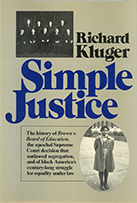 The wide attention to and enthusiastic critical reception for Simple Justice (1976) established Kluger as a fulltime writer. Given the limitations of his vision, he chose to try to make his author’s mark as a novelist, which required only a fraction of the research needed to produce large-scale works of social history. Over the next six years, he published three novels of his own, two of them historical fiction (Members of the Tribe, based loosely on the Leo Frank case, and Un-American Activities, about the coming of age of a young idealist trying to make his way during the Depression-plagued Thirties), and one co-authored with his wife, Good Goods. While these books won some strong reviews and Members of the Tribe was a considerable commercial success, Kluger then chose to return to the nonfiction field.
The wide attention to and enthusiastic critical reception for Simple Justice (1976) established Kluger as a fulltime writer. Given the limitations of his vision, he chose to try to make his author’s mark as a novelist, which required only a fraction of the research needed to produce large-scale works of social history. Over the next six years, he published three novels of his own, two of them historical fiction (Members of the Tribe, based loosely on the Leo Frank case, and Un-American Activities, about the coming of age of a young idealist trying to make his way during the Depression-plagued Thirties), and one co-authored with his wife, Good Goods. While these books won some strong reviews and Members of the Tribe was a considerable commercial success, Kluger then chose to return to the nonfiction field.
Granted access to the private records and files of the by-then defunct Herald Tribune by the Whitney family, the paper’s last owners, he approached writing its history as a means of recounting the evolution of U.S. daily journalism in general – for the Trib was unsurpassed as a practitioner of the craft. The New York Times was a more comprehensive and, eventually, far more commercially successful enterprise, but the Herald Tribune was the better written, more tightly edited, and graphically more pleasing effort; the two New York publications were the only truly national newspapers in the U.S., covering its main political, social, cultural, and economic developments as well as regional and overseas news. Again, Kluger interviewed hundreds of subjects to enrich his story, and The Paper (1986), like Simple Justice, was widely hailed and a finalist for the National Book Award.
 By then Kluger and his family had moved from Connecticut to the Princeton area of New Jersey, where they resided for the next twenty years. He and his wife collaborated on Royal Poinciana, a lark of a novel, a period-piece romance about the head housekeeper at a swank Palm Beach hotel built by Golden Age mogul Henry Flagler, and her involvement with a con artist who preyed on the hotel’s guests. Because co-authored novels were an oddity, the Klugers chose to use a pen name and submit their project to publishers based on only one-third of the manuscript. As a result, they found only one taker, the owner of a small imprint, who did next to nothing to sell the book despite highly enthusiastic prepublication reviews. Kluger did far better with his 1992 novel, The Sheriff of Nottingham, using his discovery in the bowels of Princeton’s Firestone Library that records about the sheriffs of England dated back to the era of Richard the Lionhearted and King John, the period when most tellings of the Robin Hood legend were set. More astonishingly, Kluger found that the actual sheriff of Nottingham during part of John’s reign was named in the Magna Carta as an objectionable royal officer – and further research suggested why: he was too efficient a magistrate and tax collector to suit the barons of his region, and so Kluger conceived of a novel turning the Robin Hood saga on its head and making the sheriff, whose real name was Philip Mark, the nobly embattled (and widely misunderstood) hero.
By then Kluger and his family had moved from Connecticut to the Princeton area of New Jersey, where they resided for the next twenty years. He and his wife collaborated on Royal Poinciana, a lark of a novel, a period-piece romance about the head housekeeper at a swank Palm Beach hotel built by Golden Age mogul Henry Flagler, and her involvement with a con artist who preyed on the hotel’s guests. Because co-authored novels were an oddity, the Klugers chose to use a pen name and submit their project to publishers based on only one-third of the manuscript. As a result, they found only one taker, the owner of a small imprint, who did next to nothing to sell the book despite highly enthusiastic prepublication reviews. Kluger did far better with his 1992 novel, The Sheriff of Nottingham, using his discovery in the bowels of Princeton’s Firestone Library that records about the sheriffs of England dated back to the era of Richard the Lionhearted and King John, the period when most tellings of the Robin Hood legend were set. More astonishingly, Kluger found that the actual sheriff of Nottingham during part of John’s reign was named in the Magna Carta as an objectionable royal officer – and further research suggested why: he was too efficient a magistrate and tax collector to suit the barons of his region, and so Kluger conceived of a novel turning the Robin Hood saga on its head and making the sheriff, whose real name was Philip Mark, the nobly embattled (and widely misunderstood) hero.
In the early Nineties, after years of abandoned starts, a two-hour “docudrama” adaptation of Simple Justice was aired on public television’s “American Experience” series. The TV version won renewed attention for the book and helped keep it in print, as did a revised edition (with a new last chapter) that Knopf issued in 2004 on the fiftieth anniversary of the Brown decision. The book has remained in print for more than 40 years.
By then, Kluger was also deeply involved in a critical investigation of the history of cigarette-smoking in America, a major medical scourge. Cigarettes had long been the most profitable, most heavily advertised, and most deadly American consumer product, yet nobody had undertaken a serious, full-scale book on the subject. The key for the project was the 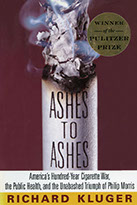 permission Kluger obtained from the executives who ran the Philip Morris Companies, makers of Marlboro and other leading brands and the most spirited defenders of the smoking habit as a personal choice of consumers, to allow him to interview them in depth in order to tell their side of the story. Kluger faithfully did so but also produced overwhelming evidence that the company and its competitors had long known precisely what they were doing in marketing their lethal wares. Once more, Kluger interviewed hundreds of people and traveled widely, while his wife, still a smoker till that point, combed through hundreds of articles in scientific and medical journals that, taken together, made clear how grave a risk smoking was to the world’s public health – and how deeply in denial were smokers, many of whom pleaded that they were hopelessly, unbreakably addicted to the habit. Ashes to Ashes (1996) was awarded the 1997 Pulitzer Prize for nonfiction.
permission Kluger obtained from the executives who ran the Philip Morris Companies, makers of Marlboro and other leading brands and the most spirited defenders of the smoking habit as a personal choice of consumers, to allow him to interview them in depth in order to tell their side of the story. Kluger faithfully did so but also produced overwhelming evidence that the company and its competitors had long known precisely what they were doing in marketing their lethal wares. Once more, Kluger interviewed hundreds of people and traveled widely, while his wife, still a smoker till that point, combed through hundreds of articles in scientific and medical journals that, taken together, made clear how grave a risk smoking was to the world’s public health – and how deeply in denial were smokers, many of whom pleaded that they were hopelessly, unbreakably addicted to the habit. Ashes to Ashes (1996) was awarded the 1997 Pulitzer Prize for nonfiction.
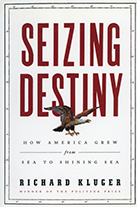 After the Klugers moved to California’s Bay Area, where their younger son and his family live, he devoted five years to crafting Seizing Destiny: How America Grew from Sea to Shining Sea – the first narrative within a single volume to chronicle the entire story of how the U.S., in a mere ninety-one years, the blink of an eye by historical reckoning, grew territorially from a weak, army-less infant republic to a territorial colossus with the fourth largest land mass of any nation on earth. It is both an admiring and sharply critical account of American national character as evinced in this tale of voracious land-grabbing.
After the Klugers moved to California’s Bay Area, where their younger son and his family live, he devoted five years to crafting Seizing Destiny: How America Grew from Sea to Shining Sea – the first narrative within a single volume to chronicle the entire story of how the U.S., in a mere ninety-one years, the blink of an eye by historical reckoning, grew territorially from a weak, army-less infant republic to a territorial colossus with the fourth largest land mass of any nation on earth. It is both an admiring and sharply critical account of American national character as evinced in this tale of voracious land-grabbing.
For his fifth and sixth books on U.S. social history, Kluger focused on a pair of episodes played out on opposite sides of the country in the eighteenth and nineteenth centuries that each dwelled on the larger national significance of the core issue at stake. The San Francisco Chronicle called his 2011 book The Bitter Waters of Medicine Creek, about the fate of a small tribe’s struggle in the 1850s to withstand the influx of white frontiersmen near Washington state’s Puget Sound, “More than just another tragic story of the American Indian, [it is] a powerful human story as necessary today as ever.” The New York Times said it was “an eloquent account of a massacre’s legacies,” and the Minneapolis Star Tribune praised it as “meticulously researched [and] elegantly written, the book uses this all but forgotten episode…to give a human face to the injustices visited on Indians in treaty-making, on the battlefield, and, surprisingly, in the courtroom.” Kluger’s most recent book, Indelible Ink, issued in the midst of the 2016 presidential election campaign, when the media’s coverage had much to do with the making of Donald Trump’s improbable victory, was the first book-length account of the events leading up to and including the 1735 trial of New York newspaper publisher John Peter Zenger, the outcome of which marked the birth of America’s free press. In a full-page review in The New York Times Book Review, former Times executive editor Bill Keller wrote that like Kluger’s The Paper, “his monumental 1986 autopsy of the New York Herald Tribune, he brings the same gifts to this…book: vivid storytelling built on exacting research, a knack for animating the context, and an exquisite sense of balance that honors this country’s essential press freedom without romanticizing its champions.”
Kluger’s wife, the former Phyllis Schlain, attended Douglass College and later graduated from Columbia University, where she majored in art history. Her academic background and a remarkable gift for the fiber arts stood her in good stead when she authored two books of her own, A Needlepoint Gallery of Patterns from the Past (Knopf) and Victorian Designs for Needlepoint (Holt, Rinehart & Winston). Phyllis is also the creator of satiric and documentary quilts with titles like “Cereal Killer Strikes Again” and “The Real George Washington, Warts and All” and dealing with, among other subjects, the rise and fall of the British empire, American homes, and the fall of Soviet communism. Her “Eureka” quilt is a proposed new state flag for California, and her six-foot-square quilt “The Princeton-Yale Game Increases in Intensity” is on permanent display at Princeton University’s Frist Student Center. The Klugers have two sons, Matthew and Ted, and six grandsons.
Author's photo by Michael Lionstar
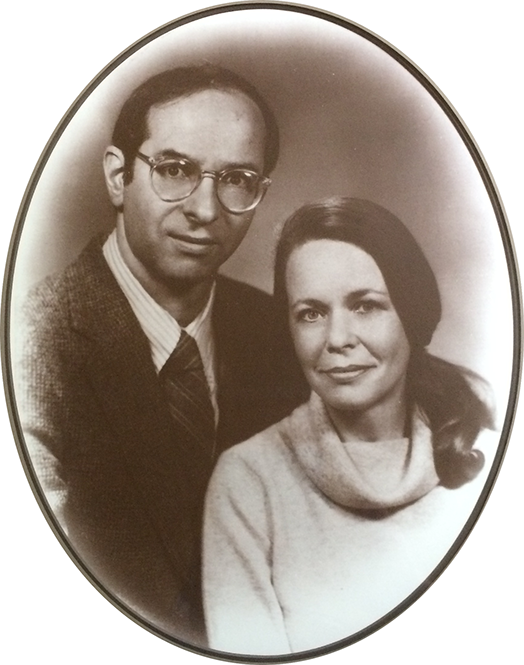
BIBLIOGAPHY
History
SIMPLE JUSTICE
A History of Brown v. Board of Education
and Black America’s Struggle for Equality
published in 1976 by Alfred A. Knopf, Inc. + Vintage paperback
THE PAPER
The Life and Death of the New York Herald Tribune
published in 1986 by Alfred A. Knopf, Inc. + Vintage paperback
ASHES TO ASHES
America’s Hundred-Year Cigarette War, the Public Health
and the Unabashed Triumph of Philip Morris
published in 1996 by Alfred A. Knopf, Inc. + Vintage paperback
SEIZING DESTINY
The Relentless Expansion of American Territory
published in 2007 by Alfred A. Knopf, Inc. + Vintage paperback
THE BITTER WATERS OF MEDICINE CREEK
A Tragic Clash Between White and Native America
published in 2011 by Alfred A. Knopf, Inc. + Vintage paperback
INDELIBLE INK
The Trials of John Peter Zenger and the Birth of America’s Free Press
published in 2016 by W.W. Norton & Co.. + Norton paperback
Fiction
WHEN THE BOUGH BREAKS
published in 1964 by Doubleday & Co. + Pocket Books paperback
NATIONAL ANTHEM
published in 1969 by Harper & Row + Hamish Hamilton (U.K.)
MEMBERS OF THE TRIBE
published in 1978 by Doubleday & Co. + Bantam paperback
STAR WITNESS
published in 1979 by Doubleday & Co.
UN-AMERICAN ACTIVITIES
published in 1982 by Doubleday & Co.
THE SHERIFF OF NOTTINGHAM
published by the Viking Press in 1992 + Penguin paperback
BEETHOVEN’S TENTH
published in 2018 by Rare Bird Books
Novels co-authored with Phyllis Kluger
GOOD GOODS
published in 1982 by Macmillan
ROYAL POINCIANA
published in 1987 under pseudonym Thea Coy Douglass
by Donald I. Fine Inc. + Pinnacle paperback
©2017 Richard Kluger